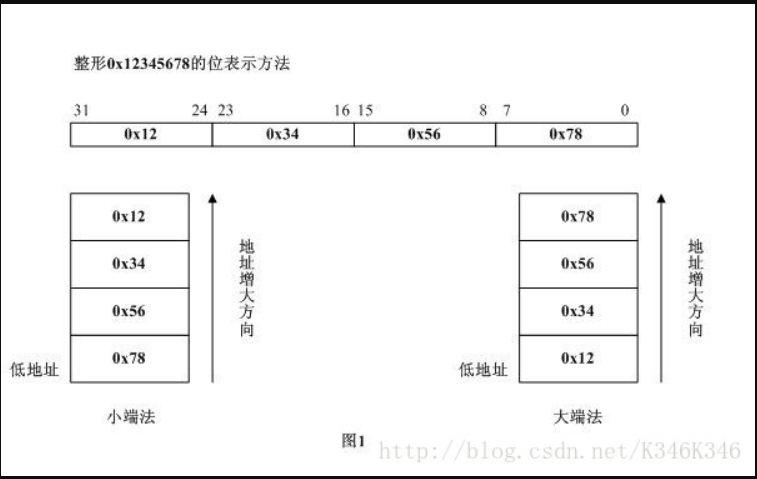datetime:2022/12/19 19:31
author:nzb
网络字节序与主机字节序
1.网络字节序与主机字节序
在Linux网络编程中,经常碰到网络字节序与主机字节序的相互转换。说到网络字节序与主机字节序需要清晰了解以下几个概念。
字节序,顾名思义,指字节在内存中存储的顺序。比如一个int32_t类型的数值占用4个字节,这4个字节在内存中的排列顺序就是字节序。字节序有两种:
- (1)小端字节序(Little endinan),数值低位存储在内存的低地址,高位存储在内存的高地址;
- (2)大端字节序(Big endian),数值高位存储在内存的低地址,低位存储在内存的高地址。
下面以32位位宽数值0x12345678为例,小端字节序与大端字节序具体的存储区别如下所示:

主机字节序,即CPU存储数据时采用的字节顺序。不同的CPU设计时采用的字节序是不同的,谈到字节序的问题,必然牵涉到两大CPU派系。 那就是Motorola的PowerPC系列CPU和Intel的x86与x86_64(该指令集由AMD率先设计推出)系列CPU。 PowerPC系列采用大端字节序(big endian)方式存储数据,而x86与x86_64系列则采用小端字节序(little endian)方式存储数据。 平常大多数PC与服务器如果使用的是Intel与AMD CPU,一般都是小端字节序(little endian)
网络字节序,是TCP/IP中规定好的一种数据表示格式,它与具体的CPU类型、操作系统等无关,从而可以保证数据在不同主机之间传输时能够被正确解释。 网络字节顺序采用大端字节序(big endian)排序方式。
如何具体判断本机的主机字节序呢?参考如下代码:
//@ret:返回0小端字节序,返回1大端字节序
int dGetHostByteOrder()
{
uint32_t a = 0x12345678;
uint8_t *p = (uint8_t *)(&a);
if(*p==0x78)
{
return 0
}
else
{
return 1;
}
}
2.网络字节序与主机字节序的相互转换
2.1常用系统调用
Linux socket网络编程中,经常会使用下面四个C标准库函数进行字节序间的转换。
#include <arpa/inet.h>
uint32_t htonl(uint32_t hostlong); //把uint32_t类型(4字节)从主机序转换到网络序, host to network long
uint16_t htons(uint16_t hostshort); //把uint16_t类型(2字节)从主机序转换到网络序,host to network short
uint32_t ntohl(uint32_t netlong); //把uint32_t类型从网络序转换到主机序
uint16_t ntohs(uint16_t netshort); //把uint16_t类型从网络序转换到主机序
2.2 64位数值的转换
现在如果需要对64位类型数据进行主机字节序与网络字节序的转换,没有现成系统API可用,可以通过下面两种方法进行转换:
2.2.1使用移位
//主机序转网络序
unsigned long long htonll(unsigned long long val)
{
if(__BYTE_ORDER == __LITTLE_ENDIAN)
{
return (((unsigned long long )htonl((int)((val << 32) >> 32))) << 32) | (unsigned int)htonl((int)(val >> 32));
}
else if (__BYTE_ORDER == __BIG_ENDIAN)
{
return val;
}
}
//网络序转主机序
unsigned long long ntohll(unsigned long long val)
{
if (__BYTE_ORDER == __LITTLE_ENDIAN)
{
return (((unsigned long long )ntohl((int)((val << 32) >> 32))) << 32) | (unsigned int)ntohl((int)(val >> 32));
}
else if (__BYTE_ORDER == __BIG_ENDIAN)
{
return val;
}
}
2.2.2使用联合体union
根据联合体的特性:联合中所有成员引用的是内存中相同的位置,其长度为最长成员的长度。
typedef struct {
unsigned int u32_h;
unsigned int u32_l;
}Int64_t;
typedef union {
unsigned long long u64;
Int64_t st64;
}Convert64_t;
//主机序转网络序
unsigned long long htonll(unsigned long long val)
{
if (__BYTE_ORDER == __LITTLE_ENDIAN)
{
Convert64_t box_in, box_out;
box_in.u64 = val;
box_out.st64.u32_h = htonl(box_in.st64.u32_l);
box_out.st64.u32_l = htonl(box_in.st64.u32_h);
return box_out.u64;
}
else if (__BYTE_ORDER == __BIG_ENDIAN)
{
return val;
}
}
//网络序转主机序
unsigned long long ntohll(unsigned long long val)
{
if (__BYTE_ORDER == __LITTLE_ENDIAN)
{
Convert64_t box_in, box_out;
box_in.u64 = val;
box_out.st64.u32_h = ntohl(box_in.st64.u32_l);
box_out.st64.u32_l = ntohl(box_in.st64.u32_h);
return box_out.u64;
}
else if(__BYTE_ORDER == __BIG_ENDIAN)
{
return val;
}
}
2.2.3使用编译器内置函数
#ifdef WIN32
#define ntohll(x) _byteswap_uint64 (x)
#define htonll(x) _byteswap_uint64 (x)
#else
#if __BYTE_ORDER == __BIG_ENDIAN
#define ntohll(x) (x)
#define htonll(x) (x)
#else
#if __BYTE_ORDER == __LITTLE_ENDIAN
#define ntohll(x) __bswap_64 (x)
#define htonll(x) __bswap_64 (x)
#endif
#endif
#endif